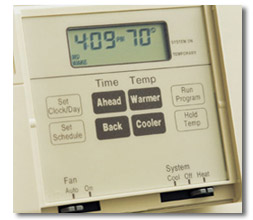What is HVAC?
Air surrounds us. For millennia, human beings did not “control” their air – we lived in trees or in caves, and took it as it was.
Heating, of course, was the first change. No one can date the invention of fire. With it, however, humans adapted to environments – enabling our species to spread all over this planet, to cold climates. But heating was pretty much limited, until relatively recently, to open hearths.
As far as anyone can tell, the first real attempt to control the thermal environment – the AC part of “HVAC” – can be seen on Egyptian inscriptions (and in Hollywood movies) . . . a slave fanning the pharaoh!
Controlling Your Environment
Your commercial building’s HVAC system is not much more than an evolved, sophisticated expansion of the common hearth and pharaoh’s fan. We’re many generations away from those days, in both human time-tracking and HVAC evolution.
 Today, we can distribute warm or cool air via ductwork that runs throughout a building.
Today, we can distribute warm or cool air via ductwork that runs throughout a building.
Humans at work in a building need to be comfortable, healthy, and productive. Your HVAC system must distribute warm air, when needed, to where it is needed. In summer, when workers might be unproductive as temperatures approach 90 degrees (with high humidity), your HVAC system provides a reasonable climate.
But things can go wrong. People “feel” a problem with an HVAC system almost before they verbalize it. You know when something is amiss with these systems when you hear that “it” is “too” something – too hot or too cold.
Or the complaint might come to you as “there’s not enough air in here.”
Human Health & Comfort
Properly installed and maintained, HVAC systems create a building’s environment – they are more a part of that building than the carpet, the wall treatments, or the furniture. Your HVAC machinery is vital to the health and emotional well-being of humans, who occupy the building for 10 to 12 hours a day.
 Modern controls give building occupants a modicum of control. If the 11th floor features a lot of activity, the tenant there might want “it” to be 68 degrees (Farenheit). On the 17th floor, however, another company might be photographing fashion models who frequently change outfits; they might see 68 as unreasonable. That’s not a problem!
Modern controls give building occupants a modicum of control. If the 11th floor features a lot of activity, the tenant there might want “it” to be 68 degrees (Farenheit). On the 17th floor, however, another company might be photographing fashion models who frequently change outfits; they might see 68 as unreasonable. That’s not a problem!
Problems with HVAC systems come in many forms: unfortunate design, substandard installation, or poor maintenance. Machinery breaks down over time. Sometimes it’s “too loud” or is vibrating noticeably . . . a sign of problems to come.
How can you make these problems go away? That’s the focus of the rest of this commercial building section.
